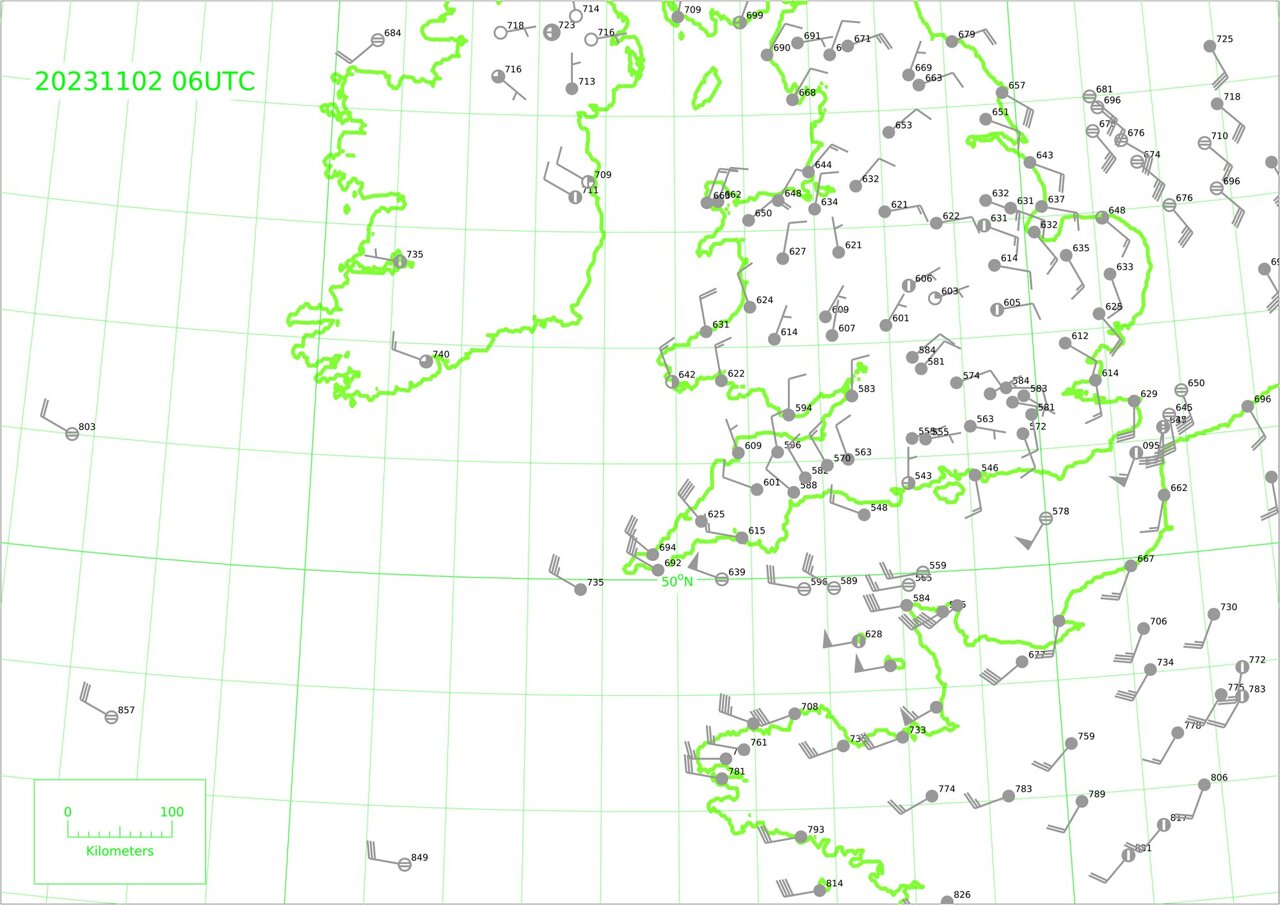
Storm Ciaran batters Folkestone and the large waves form a Lions face in the waves.
From Meteo Tech Int by Elisabeth Baker
The University of Reading has released a study that highlights the rapid progress and transformative potential of artificial intelligence (AI) in weather prediction through an analysis of November 2023’s Storm Ciaran.
Machine learning in weather prediction
According to the researchers, AI can quickly and accurately predict the path and intensity of major storms.
The research suggests weather forecasts that use machine learning (ML) can produce predictions of similar accuracy to traditional forecasts faster, cheaper and using less computational power.
Surface land and ship station SYNOP observations of Storm Ciarán at 06 UTC 2 November 2023 extracted from the MetDB database, which holds data including surface and upper air observations and some satellite data.
Credit: npj Climate and Atmospheric Science (2024).
DOI: 10.1038/s41612-024-00638-w © Provided by Phys.org
The University of Reading study has now been published in npj Climate and Atmospheric Science.
Professor Andrew Charlton-Perez, who led the study, said, “AI is transforming weather forecasting before our eyes.
Two years ago, modern machine learning techniques were rarely being applied to make weather forecasts.
Now we have multiple models that can produce 10-day global forecasts in minutes.
“There is a great deal we can learn about AI weather forecasts by stress-testing them on extreme events like Storm Ciarán. We can identify their strengths and weaknesses and guide the development of even better AI forecasting technology to help protect people and property. This is an exciting and important time for weather forecasting.”
“There is a great deal we can learn about AI weather forecasts by stress-testing them on extreme events like Storm Ciarán. We can identify their strengths and weaknesses and guide the development of even better AI forecasting technology to help protect people and property. This is an exciting and important time for weather forecasting.”
Promise and pitfalls
To understand the effectiveness of AI-based weather models, scientists from the University of Reading compared AI and physics-based forecasts of Storm Ciarán – a windstorm that hit northern and central Europe in November 2023 which claimed 16 lives in northern Europe and left more than a million homes without power in France.
The researchers used four AI models and compared their results with traditional physics-based models. The AI models, developed by companies like Google, Nvidia and Huawei, were able to predict the storm’s rapid intensification and track 48 hours in advance.
To a large extent, the forecasts were “indistinguishable” from the performance of conventional forecasting models, the researchers said.
The AI models also accurately captured the large-scale atmospheric conditions that fueled Ciarán’s explosive development, such as its position relative to the jet stream – a narrow corridor of strong high-level winds.
The ML technology underestimated the storm’s damaging winds, however.
The ML technology underestimated the storm’s damaging winds, however.
All four AI systems underestimated Ciarán’s maximum wind speeds, which in reality gusted at speeds of up to 111 knots at Pointe du Raz, Brittany.
The authors were able to show that this underestimation was linked to some of the features of the storm, including the temperature contrasts near its center, that were not well predicted by the AI systems.
To better protect people from extreme weather like Storm Ciaran, the researchers say further investigation of the use of AI in weather prediction is urgently needed to save forecasters time and money.
To better protect people from extreme weather like Storm Ciaran, the researchers say further investigation of the use of AI in weather prediction is urgently needed to save forecasters time and money.
Links :
- MetTechInt : DTN releases AI-powered tropical storm forecast model
- Nature : Do AI models produce better weather forecasts than physics-based models? A quantitative evaluation case study of Storm Ciarán
- MeteoRed : How well can AI weather forecast models predict extreme events like Storm Ciarán?
- GeoGarage blog : Google DeepMind's AI weather forecaster handily beats a ... / The danger of leaving weatherprediction to AI / How the latest advances in machine learning are enabling ... / AI breakthroughs could improve weather forecasts / AI hurricane predictions are storming the world of weather ... / Google AI model outperforms traditional methods of ... / IBM extends NASA collaboration to apply generative AI to weather / How NASA, NOAA and AI might save the internet from ... / New model based on Artificial Intelligence available in ... / AI on the high seas: Digital transformation is revolutionizing ... / Better weather forecasts coming to the developing world

No comments:
Post a Comment